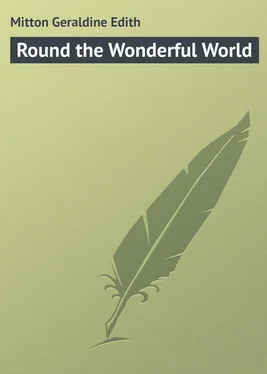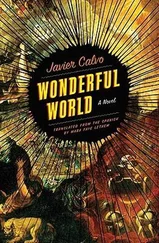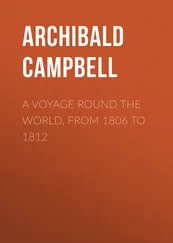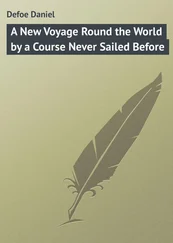Geraldine Mitton - Round the Wonderful World
Здесь есть возможность читать онлайн «Geraldine Mitton - Round the Wonderful World» — ознакомительный отрывок электронной книги совершенно бесплатно, а после прочтения отрывка купить полную версию. В некоторых случаях можно слушать аудио, скачать через торрент в формате fb2 и присутствует краткое содержание. Жанр: Путешествия и география, foreign_prose, foreign_language, на английском языке. Описание произведения, (предисловие) а так же отзывы посетителей доступны на портале библиотеки ЛибКат.
- Название:Round the Wonderful World
- Автор:
- Жанр:
- Год:неизвестен
- ISBN:нет данных
- Рейтинг книги:4 / 5. Голосов: 1
-
Избранное:Добавить в избранное
- Отзывы:
-
Ваша оценка:
- 80
- 1
- 2
- 3
- 4
- 5
Round the Wonderful World: краткое содержание, описание и аннотация
Предлагаем к чтению аннотацию, описание, краткое содержание или предисловие (зависит от того, что написал сам автор книги «Round the Wonderful World»). Если вы не нашли необходимую информацию о книге — напишите в комментариях, мы постараемся отыскать её.
Round the Wonderful World — читать онлайн ознакомительный отрывок
Ниже представлен текст книги, разбитый по страницам. Система сохранения места последней прочитанной страницы, позволяет с удобством читать онлайн бесплатно книгу «Round the Wonderful World», без необходимости каждый раз заново искать на чём Вы остановились. Поставьте закладку, и сможете в любой момент перейти на страницу, на которой закончили чтение.
Интервал:
Закладка:
Marseilles is the largest seaport in France, and is second only to Paris in size and importance.
Do you know those preserved fruits which generally appear about Christmas-time in oval cardboard or long wooden boxes? Have you ever wondered if they are real fruit, and where they come from? They are real fruit, boiled and dipped in syrup, though they taste very different from the same fruit freshly gathered. A great deal of the preserving is done in France, especially along the south coast, and when we get to Marseilles we are in the very heart of the business.
After passing the night in an hotel we have time to wander about a bit before going down to the docks to find our ship.
The sun is shining brightly as we turn out after another breakfast, which only seems to have given an edge to our keen British appetites. There is a nasty cold wind blowing round corners and buffeting people. The pavements are very lively; we see women and girls hurrying about doing household shopping, and boys in heavy cloth capes and military caps, so that they look like cadets, this is the uniform worn by better-class schoolboys in France. The French policemen, called gendarmes, are also in uniform of so military a kind that unless we knew we should certainly mistake them for soldiers.
There are stalls set out on the pavements, heaped up with embroidery and odds and ends, including soap, which is manufactured here very largely. Bright-eyed girls try to entice us to buy as we pass. One street is just like a flower garden, lined with stalls piled up with violets and roses and anemones and other blossoms. Trams follow one another along the rails in an endless procession. We walk on briskly and turn down a side street; here at last is what I have been looking for, and well worth finding it is too! It is a shop with great plate-glass windows; on one side is every kind of preserved fruit, and on the other a variety of chocolates, tarts, and expensive sweets. Look at that dainty box filled with dark green figs, artistically set off by sugared violets pressed into all the niches! These are rather different from the flat, dry brown figs which is all that English children recognise under that name. Another box glows with tiny oranges, mandarins they call them here, and piled up over them are richly coloured cherries shining with sugar crystals. In the centre is an enormous fruit like a dark orange-coloured melon, surrounded by heaps of others, while the plain brown chestnuts, that don't attract much notice, are really the best of all, for they are the marrons glacés for which Marseilles is famed, and once you have tasted these, freshly made, all other sweets will seem insipid to you.
Inside the shop there are many carefully dressed ladies, daintily holding little plates, and going about from one counter to another, picking up little cakes filled with cream and soaked in syrup. They eat scores of them, and they do it every day and any hour of the day, in the morning or afternoon or whenever they happen to pass. No wonder they look pasty-faced! We are only here for once, so we need have no compunction about our digestions, especially as there is an empty place left after that tantalising bacon-less breakfast. We are soon provided with a plate each and a little implement which looks as if it had started life as a butter-knife and suddenly changed its mind to become a fork.
The shop-girls take no notice of what we eat; we can pick and choose freely, and at the end they trust us to say how many cakes we have had. We can get here also cups of thick rich chocolate, and, if we wanted it, some tea, though it is only of late years that French people have taken to drinking tea at all freely, for coffee is their national beverage.
Well, come along, tear yourself away, we must get a cab and go down to our ship which is at the docks.
In the cab we pass what is called the Old Port with picturesque rows of weather-beaten sailing boats; only the sailing boats are allowed to come in here. Rising up against the sky at the far end of the port is a curious bridge quite unlike any other you have seen, for the bridge part is at a great height and there is nothing below by which people or vehicles can cross over. How is anyone going to take the trouble to climb up there? How, above all, are carts or carriages going to manage it?
You can easily make a rough model to see the principle of this bridge for yourself. Get a couple of the tallest candlesticks in the house, and put a stick across them, run a curtain ring on to the stick, and to the ring attach numerous threads fastened at the lower end to a flat bit of card or board like a raft. Then, by pushing the ring along the stick, you can make the raft follow across below. The stick represents the high bridge, and the raft in reality rests on the surface of the water, and when the machinery above, represented by the ring, is set in motion, it rumbles across and draws with it the floating raft, which is large enough to take a great number of men and vehicles. Every ten minutes or so this floating bridge passes over from one side to another, and people pay a sou, which is the French halfpenny, to travel with it. Thus, you see, when a tall ship comes in she has only to avoid the raft, and she can sail in beneath the high bridge without any trouble. We could, if we wished, go up in a lift to the high bridge; but the railings up there are far apart, and there is a high wind blowing, you are not very big, and if you slipped between I should have to give up my voyage round the world; so I think we won't, if you don't mind!
Besides, we have to catch our ship waiting at the docks, and she will be off very soon.
Now that you have heard what we should probably do and see if we went across France, will you take this journey or will you start from England and go right round in the ship?
You answer that though you would like to see the little blue-bloused porters, and that it would amuse you to think that the little French boys and girls could speak no English, and though you would certainly love the marrons glacés , you think, after all, having heard about it, we might just as well go the other way round, though, of course – the marrons glacés —
Sensible boy! Forget about them! We'll go round. In the very next chapter we'll be up and off in earnest.
CHAPTER II
REALLY OFF!
It is exciting to start on any journey, even if it is only one we have done before, but to go off round the world that is a real adventure!
There are many lines of steamers we could choose to go by, but we will select for this first part of the journey the Orient Line. The choice really lies between that and the P. & O., as we have already decided, and for many reasons it is best to begin with the Orient and join the other later. The main reason being that I want you to see a little of as many European countries as possible, and the Orient ships stop at Naples, in Italy, while those of the other line do not.
The ships in the Orient fleet all begin with an O; there are the Otranto , Otway , and many more, but the boat which suits us and happens to sail on the date we want to start – in the beginning of November – is the Orontes . She is not the largest ship in the fleet, having about half a dozen before her on the list, but she is a good ship and very steady.
Our jumping-off place is London, whence a special train runs from the station of St. Pancras down to the docks at Tilbury, where the Orontes is waiting for us. The long platform beside the train is covered with people when we arrive there, so that we have some difficulty in finding seats. If all these people were coming with us we should have a full ship indeed, but the one half of them is only seeing the other half off!
Читать дальшеИнтервал:
Закладка:
Похожие книги на «Round the Wonderful World»
Представляем Вашему вниманию похожие книги на «Round the Wonderful World» списком для выбора. Мы отобрали схожую по названию и смыслу литературу в надежде предоставить читателям больше вариантов отыскать новые, интересные, ещё непрочитанные произведения.
Обсуждение, отзывы о книге «Round the Wonderful World» и просто собственные мнения читателей. Оставьте ваши комментарии, напишите, что Вы думаете о произведении, его смысле или главных героях. Укажите что конкретно понравилось, а что нет, и почему Вы так считаете.












